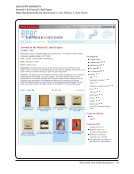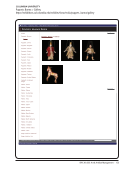52 · Survey Results: Survey Questions and Responses
Challenge 1 Challenge 2 Challenge 3
We self-limit in acquisitions by size of
art object due to archival lack of space.
Some collections are acquired and stored
offsite at Walnut Warehouse.
Staffing to create finding aids and
conduct archival processing on the
hundreds of unprocessed manuscript
collections in both Archives and Special
Collections. The new reorganization
should help--it’s just slow going right
now.
Funding. At times we have to pass on
material because our pockets aren’t that
deep.
Western Archives: Size and shape often
require special containers/storage
arrangements. Music Special Collections:
Staffing to create proper finding aids,
includes skills set and time to create
them.
Western Archives: Have to be maintained
physically separate from rest of fonds/
collection. Music Special Collections:
Proper display and housing for collection.
Music Special Collections: Patron
accessibility would likely be solved if
challenges 1 &2 were addressed.
While art and artifacts are housed
separately, whenever appropriate they
are described in the context of the
collection to which they belong. While
not a challenge per se, this aspect wasn’t
addressed in the arrangement and
description question.
We focus very little time on artifacts,
somewhat more on art, as it is a
significant component of our children’s
literature collections. It’s hard enough to
keep up with description for our primary
collections (archives and rare books)-
-there is little time left for artifacts
particularly.
Working with several different systems
(Archivists’ Toolkit, MS Access, SCREAD,
legacy finding aids) makes it difficult to
manage. We are getting closer to having
all of our collections documented in AT.
For the most part we do not have item
level description/control of our art and
artifact collections. Materials are treated
archivally. Some collections contain
several thousand boxes, such as the
papers of architect Richard Neutra and A.
Quincy Jones or the LA Times Photograph
Archive.
Space and storage of larger items.
Successful Strategies for Managing Art Objects and Artifacts
35. Please briefly describe up to three of your most successful strategies for managing art objects and/
or artifacts. N=55
Strategy 1 Strategy 2 Strategy 3
Accompanying descriptive text with a
scanned image, when possible.
Using a database such as PastPerfect
that is designed specifically for a wide
array of objects. (Although it still doesn't
adequately address all of our needs as a
theatre special collection.)
Challenge 1 Challenge 2 Challenge 3
We self-limit in acquisitions by size of
art object due to archival lack of space.
Some collections are acquired and stored
offsite at Walnut Warehouse.
Staffing to create finding aids and
conduct archival processing on the
hundreds of unprocessed manuscript
collections in both Archives and Special
Collections. The new reorganization
should help--it’s just slow going right
now.
Funding. At times we have to pass on
material because our pockets aren’t that
deep.
Western Archives: Size and shape often
require special containers/storage
arrangements. Music Special Collections:
Staffing to create proper finding aids,
includes skills set and time to create
them.
Western Archives: Have to be maintained
physically separate from rest of fonds/
collection. Music Special Collections:
Proper display and housing for collection.
Music Special Collections: Patron
accessibility would likely be solved if
challenges 1 &2 were addressed.
While art and artifacts are housed
separately, whenever appropriate they
are described in the context of the
collection to which they belong. While
not a challenge per se, this aspect wasn’t
addressed in the arrangement and
description question.
We focus very little time on artifacts,
somewhat more on art, as it is a
significant component of our children’s
literature collections. It’s hard enough to
keep up with description for our primary
collections (archives and rare books)-
-there is little time left for artifacts
particularly.
Working with several different systems
(Archivists’ Toolkit, MS Access, SCREAD,
legacy finding aids) makes it difficult to
manage. We are getting closer to having
all of our collections documented in AT.
For the most part we do not have item
level description/control of our art and
artifact collections. Materials are treated
archivally. Some collections contain
several thousand boxes, such as the
papers of architect Richard Neutra and A.
Quincy Jones or the LA Times Photograph
Archive.
Space and storage of larger items.
Successful Strategies for Managing Art Objects and Artifacts
35. Please briefly describe up to three of your most successful strategies for managing art objects and/
or artifacts. N=55
Strategy 1 Strategy 2 Strategy 3
Accompanying descriptive text with a
scanned image, when possible.
Using a database such as PastPerfect
that is designed specifically for a wide
array of objects. (Although it still doesn't
adequately address all of our needs as a
theatre special collection.)


















































































































































































